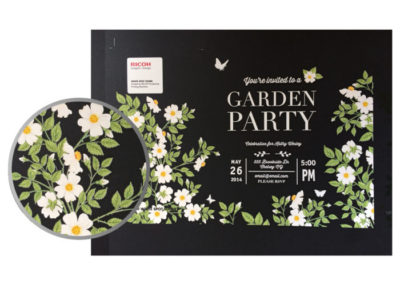White Ink Digital Printing: Everything you Need to Know
Have you ever wondered what effects and printing results you could get using white ink? PCG explains to you the benefits of using this ink for your printing works and all you need to know about it.
Unlike CMYK inks, white toner is completely opaque and covering.
It can be combined with different inks and finishes, such as clear varnish (Clear) or fluorescent inks (Neon Pink and Yellow), for example. White ink printing is possible on different types of media, for a multitude of original and interesting effects.
The combination possibilities are very numerous and can create different styles. That is the reason why printing with white ink is interesting to different types of customers.
Whether you are a small, medium or large company, a freelance, a graphic designer, or an artist, the use of white ink allows you to obtain elegant, original, personalized and highly visual products.
The different uses of white ink depending on the support
You can use it for different purposes, depending on what support you are using and what effects you are looking for
Delimitation and sharpness
Combined with CMYK inks, it gives you neater image outlines. It results in clearer printings over colored, dark or metallic substrates or very absorbing supports, such as offset papers or uncoated cardboard paper

White ink printing with CMYK to delimitate the outlines

White ink and CMYK printing on red cardboard paper
Vibrant colors
The opacity of white ink brightens CMYK inks’ colors, they seem more vivid when you first print a layer of white toner, especially on colored or dark papers, and too absorbing supports.
High Contrast and Visibility
White ink is more visible, thanks to its opacity it contrasts more with colored or dark supports

White ink on black paper

White ink and CMYK on transparent adhesive
Better color rendering
It can be used as a base ink on translucent or transparent supports to avoid altering the CMYK inks’ color rendering, since the later are less covering
Identification and security
It can be used to print on white supports to create watermarks. This is an easy way to secure and identify your documents.

White ink printing on white paper
White ink printing is often used to personalize flyers, brochures, business cards, greeting cards, postcards, invitations, book covers, annual company reports, catalogs, posters, labels, tags, stickers…
Different supports can be used to print with white toner:
-
Synthetics such as polyester (white, transparent or translucent)
-
Coated and uncoated papers
-
Textured papers
-
Metallic papers
-
Colored papers
-
Adhesive papers
-
Recycled papers
-
Kraft papers
- Cardboard papers
Attention: Make sure you prepare your files for printing by specifying your document’s white ink printing areas on Illustrator, InDesign or Corel! You can add white as a 5th ink on top of the CMYK ones.
Reasons for using white ink:
White toner creates contrast for striking and original communication supports. White ink on dark subtrates makes your message more visible thanks to the contrast and does not tire the eye.
On top of black, it gives a subtle effect. It is very elegant combined with gold or silver metallic paper or finishes.

At PCG, we have just purchased the Ricoh Pro C7100x printer. This printer allows us to add a fifth color, to print with clear ink, pink fluorescent ink, or white ink. We can now offer you even more personalized printing products to stand out.
Contact with PCG
If you need a personalised quotation or would like our team to provide you with assessment for your projects, please feel free to contact us. We are a team of professionals from the sector that will look after your project from beginning to end.
